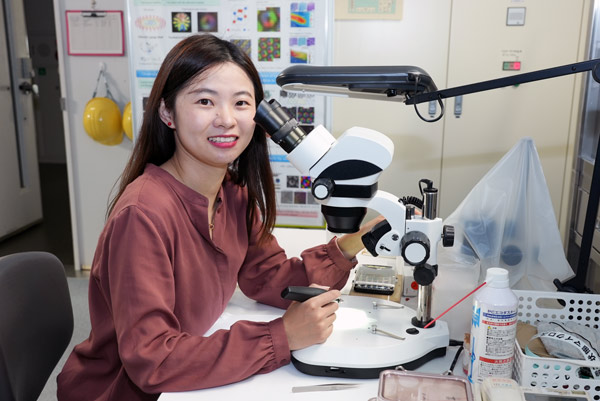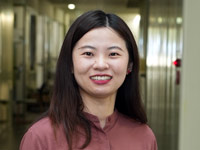Mar. 25, 2022
Skyrmion’s the limit
Licong Peng, Special Postdoctoral Researcher
Please describe your role at RIKEN.
I am a special postdoctoral researcher in the Electronics States Microscopy Research Team at RIKEN Center for Emergent Matter Science (CEMS), led by Xiuzhen Yu. I use Lorentz transmission electron microscopy to perform real-space observations of magnetic vortex-like particles and anti-particles, and then drive and control their dynamic behaviors in spintronic devices that we fabricate. This could be useful to energy-saving magnetic recording storage devices, for example, because their controllability can be enabled at an ultralow threshold electric current.
What excites you the most about your current research?
Recently, we have, for the first time, been able to directly drive and control the motion of a single nanometric skyrmion at room temperature, and have demonstrated the first experimental evidence to confirm the universal behaviors or skyrmion motion in chiral-lattice magnets. This is very exciting research since the controllability of a single skyrmion at room temperature is one of the keys to spintronic devices.

What do you think has been the most interesting discovery in the last few years?
In 2020, we directly controlled the topological nature of nanometric skyrmions ('particles') and anti-skyrmions ('anti-particles'), including controlling their topological numbers, helicity and lattice form. The transformations between skyrmions and anti-skyrmions could be used to transmit information in the same ways as bits, in which a skyrmion is a 1 bit and antiskyrmion is a 0 bit, in magnetic recording devices. After this discovery, many researchers started to investigate the properties of anti-skyrmions, including their three-dimensional tomography, heating/current-induced dynamics and transport properties. Some also began to search for anti-skyrmion-hosting new materials (see here).
How and when did you join RIKEN?
Xiuzhen Yu, who leads the Electronics States Microscopy Research Team in RIKEN CEMS is the world’s leading expert in real-space exploration of topological textures and novel emergent phenomena. I read a lot of high-impact research papers by Dr. Yu and Professor Yoshinori Tokura (the center director). I was keen to join Yu’s team and also very curious about how they published such pioneering work. Hence, I applied for a position and luckily became the first postdoctoral researcher in her team in 2018.
What has been your most memorable experience at RIKEN?
Sometimes, we will have research progress meetings every Monday, Tuesday and Wednesday to foster collaboration between teams. Such frequent discussions allow the PIs and professors to follow up on experimental details, and we can glean valuable suggestions.
Please tell us about your professional and personal goals.
I hope in future that skyrmion-based spintronic devices will be used in real life. A personal goal is to be an independent principal investigator at a top Chinese university and to set up my own research laboratory with both experimental and theoretical sections. I would also like to build advanced experimental platforms with equipment such as Lorentz transmission electron microscopes and nanofabrication systems.

